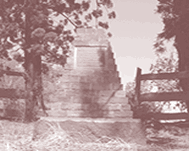Indigenous - Koori
Blacktown, Prospect, Toongabbie and Rooty Hill and other areas have an extensive Koori history that includes armed resistance, the legend of warrior Pemulway, and also unfortunately dispossession, misery, loss and frustration.
The social policy of the then Government of New South Wales was aimed at the assimilation of the Koori population. This led to boys and girls being taken from their parents to be given instruction in skills that suited the white population's needs. The amount of pay allocated to them was miniscule and as it wasn't actually paid anyway it was in reality a form of slavery.
The colonial Government of NSW in an attempt of assimilation incarcerated Kooris at the Parramatta Native Institution and later at the Cootamundra Girls School.
The attempt at forcing a totally foreign culture on individuals at Parramatta failed miserably as they kept running away from the institution or from their allotted new "homes" and eventually the Government gave up and the group was subsequently moved west of Sydney's third farming area, Toongabbie, to the Native Institution near Rooty Hill.
Individual land grants had been granted to two local Dharug men, Colebee and Nurangingy. Believed to be a reward for what were essentially acts of betrayal of the other clans in the surrounding areas - they had been employed as black trackers to hunt down other Kooris in surrounding areas. In their defence, I don't think they actually were able to find any, (probably saying "Sure those blackfellas are very quick - all gone now" or "They went this way" pointing the party in the opposite direction). Times were tough and the real villain was the colonial Government of NSW. Divide and conquer was the government's modus operandi.
At any rate, they were richly rewarded by the Governor. Other Kooris tended to congregate in that area and eventually the grant area became known as the Blacks Town. The road to their town was called the Blacks Town Road. After time the 's' was dropped and the area became to be called Blacktown and the road, Blacktown Road.
The local Koori language group Darug, Dharug or Dharruk extended from Botany Bay to the Blue Mountains and from Appin to the Hawkesbury River. Various dialects distinguished one clan group from another. The coastal clans were known as the Eora or Iyora, the dialect that they spoke was also spoken by some indigenous people in Parramatta.
Commandant Philip Gridley King described a visit to Parramatta in 1790:
"After dinner, I accompanied the governor from Rose-Hill to Propect-Hill, which is about four miles distant: we walked through a very pleasant tract of country, which, from the distance the trees grew from each other, and the gentle hills and dales, and rising slopes covered with grass, appeared like a vast park. The soil from Rose-Hill to Prospect-Hill is nearly alike, being a loam and clay. It is remarkable that although the distance between these two places is only four miles, yet the natives divide it into eight different districts."
In the 1790's Parramatta, Toongabbie and Prospect were the western frontier of white settlement and these areas experienced fierce Koori resistance to the white presence. The most significant of this group, was a man named Pemulway, a warrior who hailed from the Georges River area south east of Prospect Creek. Pemulway attacked settlements ranging from Rydalmere through Dundas, Parramatta, Toongabbie and Prospect.
The Koori lifestyle became severely restricted and disrupted by white presence. They could no longer freely fish or gather food and this and other restrictions lead to confrontation. Eventually the Koori warrior Pemulway was jailed in 1797 released and later outlawed in 1801.
Pemulway's jailing followed capture during a major confrontation which took place on the Northern Boundary Farms, near Parramatta in which history tells us that five Koori, one white man and one white woman were killed. Pemulway and others fought with their traditional weapons in this case spears - while their opponents were armed with deadly muskets.
David Collins, then a marine officer with the First Fleet describes the incident as follows:
"being fatigued with their march (the soldiers had pursued a group of 100), they entered the town, and in about one hour after were followed by a large body of natives, headed by Pe-mul-way, a riotous and troublesome savage. These were known by the settlers to be the same who had so frequently annoyed them: and they intended, if possible, to seize Pe-mul-way; who, in a rage, threatened to spear the first man that dared to approach him, and actually did throw a spear at one of the soldiers. The conflict was now begun; a musket was immediately leveled at the principal, which severely wounded him. Many spears were thrown, and one man was hit in the arm; upon which the superior effect of our fire-arms was immediately shown them, and five were instantly killed."
Pemulway was hospitalized with buckshot in his head and body yet escaped from hospital, still wearing leg irons. Followed a campaign that led to the myth that Pemulway could not be harmed by bullets and the numerous attacks in the area from them on were attributed rightly or wrongly to him.
|



